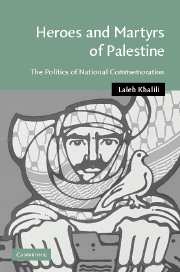Book contents
- Frontmatter
- Contents
- Acknowledgments
- List of abbreviations
- 1 Introduction
- 2 Transnational movements and discourses
- 3 Palestinian lives and local institutions in the camps of Lebanon
- 4 Forms of commemoration
- 5 Contents of commemoration: narratives of heroism, suffering, and sumud
- 6 Guerrillas and martyrs: the evolution of national “heroes”
- 7 Between battles and massacres: commemorating violent events
- 8 Commemoration in the Occupied Palestinian Territories
- 9 Conclusions
- Bibliography
- Index
- Cambridge Middle East Studies 27
6 - Guerrillas and martyrs: the evolution of national “heroes”
Published online by Cambridge University Press: 22 September 2009
- Frontmatter
- Contents
- Acknowledgments
- List of abbreviations
- 1 Introduction
- 2 Transnational movements and discourses
- 3 Palestinian lives and local institutions in the camps of Lebanon
- 4 Forms of commemoration
- 5 Contents of commemoration: narratives of heroism, suffering, and sumud
- 6 Guerrillas and martyrs: the evolution of national “heroes”
- 7 Between battles and massacres: commemorating violent events
- 8 Commemoration in the Occupied Palestinian Territories
- 9 Conclusions
- Bibliography
- Index
- Cambridge Middle East Studies 27
Summary
why talk of beauty what could be more beautiful than these heroic happy dead
who rushed like lions to the roaring slaughter
e.e. cummings, “next to of course god america i love you”During May 2002, a “Memorial Exhibition” titled 100 Shaheeds, 100 Lives was held at the UNESCO Palace in Beirut. The exhibition was planned to coincide with the fifty-fourth anniversary of the Nakba on 15 May. Despite severe restrictions on leaving the OPT and entering Lebanon, exhibition organizers had brought the artefacts – which consisted of objects belonging to and photographs of the first 100 martyrs of the second Intifada – from Ramallah to Beirut. The Ramallah organizer of the exhibition was the Khalil Sakakini Cultural Centre; its Beiruti counterparts included the Arab Resource Centre for Popular Arts. The 100 martyrs were the first 100 casualties of the al-Aqsa Intifada killed by Israeli gunfire during protests, stone-throwing, in suspicious circumstances, or as bystanders.
The exhibition of quotidian objects belonging to the deceased was accompanied by a sophisticated modern arts exhibition, a concert, and a film festival. The attendees – particularly on the opening night when a Palestinian singer from Ramallah was set to appear – represented a wide social spectrum: Lebanese leftists of all sectarian backgrounds, Lebanese Islamists, middle- and upper-class assimilated Palestinians, Lebanese and Palestinian intellectuals and artists, international activists, and last but certainly not least in numbers, Palestinians from the camps in Beirut and further afield.
- Type
- Chapter
- Information
- Heroes and Martyrs of PalestineThe Politics of National Commemoration, pp. 113 - 149Publisher: Cambridge University PressPrint publication year: 2007



